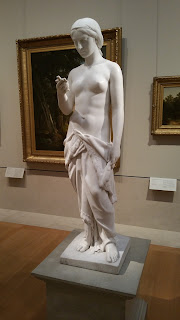The Metropolitan Museum of Art, located near the heart of Central Park on 81st and fifth avenue, is home to over a million differents texts. These texts are primarily paintings that have originated in various times throughout history. Logistically, the texts are separated into sections based on their origin and message. Some examples of the texts available in the Met are Greco-Roman art, Egyptian art, American art, and Chinese art. I recently visited the museum and explored most of the sections, and one that caught my attention was the American art section.
Upon entering the American art section, a multi-story part of the museum known as the American Wing, one will see some of the most prominent and well-known figures in American history. Figures such as George Washington and Abraham Lincoln are usually depicted on very large vertical paintings within a bright golden/yellow frame that spans nearly an entire wall. I continued walking through the American Wing past these texts, and I soon found myself amidst vivid depictions of several different points throughout American History. These included historical moments such as the Revolutionary War, Civil War, and the Spanish conquests of Native American land.
One room that stood out due to its simplicity was a relatively small room that contained paintings of seas with strong waves (seen in the background of the “dark” image above). At first, I couldn’t understand why a room, albeit small, would be dedicated to pictures of bright backgrounds and rich blue waves. A piece of information that I have been given by the American Wing information desk is that “there is often more than meets the eye”. I quickly realized that hidden in a corner, there was a dark statue of a man whose face was barely visible. The bronze statue, created by Augustus Saint Gaudens, is a monument of Deacon Samuel Chapin. The statue is referred to as “The Puritan”, which indicates that it represents most Puritans in the 16th and 17th century. Some of the key aspects of the text are that the man seems like he is trying to hide himself by wearing a large hat and overcoat/cape. He is also holding a book in his left hand which is unmarked, but I interpreted the book being as being the Bible. In the 16th and 17th centuries, Puritans that separated from the Church of England were often considered extremist, so it is clear why Puritans did not want to be in the spotlight.
In a room directly adjacent to the one that contained the aforementioned sculpture, there was a shockingly similar use of background and setting to direct one’s focus on a particular text. This room, of similar size to the room with “The Puritan”, contained many paintings of dark forests with miniscule amounts of light passing through the trees. The brightness in the room was instead portrayed through a statue in the middle. In the middle of the room stands a statue made of marble, which has a very “bone-white” color that stands out in an otherwise dark-themed room of forests. This completely contrasts the previous room, and I found this attention to detail particularly interesting. The statue is a semi-nude, topless female referred to as the “Indian Girl”, according to the sculptor. The critical aspects of this sculpture are what the Indian girl is holding in her hands. The statue’s eyes are focused on her right hand that contains a crucifix. The Indian girl is holding feathers in her left hand, which are held below her waist and not the main focus for the girl. Since the girl was Indian, I thought the feathers represented divinity to a creature such as the Quetzal Serpent as discussed in our class based on the Popol Vuh. Therefore, I believe this statue symbolizes evangelization in America in which indigenous people were slowly being converted to Christianity. Overall, the attention to detail by the museum, creators of exhibits, and artists, is truly extraordinary. It is certainly remarkable the difference that a light or dark color, whether through a background or setting, can make in a religious message.
In a room directly adjacent to the one that contained the aforementioned sculpture, there was a shockingly similar use of background and setting to direct one’s focus on a particular text. This room, of similar size to the room with “The Puritan”, contained many paintings of dark forests with miniscule amounts of light passing through the trees. The brightness in the room was instead portrayed through a statue in the middle. In the middle of the room stands a statue made of marble, which has a very “bone-white” color that stands out in an otherwise dark-themed room of forests. This completely contrasts the previous room, and I found this attention to detail particularly interesting. The statue is a semi-nude, topless female referred to as the “Indian Girl”, according to the sculptor. The critical aspects of this sculpture are what the Indian girl is holding in her hands. The statue’s eyes are focused on her right hand that contains a crucifix. The Indian girl is holding feathers in her left hand, which are held below her waist and not the main focus for the girl. Since the girl was Indian, I thought the feathers represented divinity to a creature such as the Quetzal Serpent as discussed in our class based on the Popol Vuh. Therefore, I believe this statue symbolizes evangelization in America in which indigenous people were slowly being converted to Christianity. Overall, the attention to detail by the museum, creators of exhibits, and artists, is truly extraordinary. It is certainly remarkable the difference that a light or dark color, whether through a background or setting, can make in a religious message.


No comments:
Post a Comment